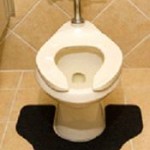Fecal matter carries diseases that are transmittable via toilet seats and unsanitary washroom surfaces. This makes bathrooms one of the germiest places on earth. Proper hygiene and sanitation practices in your community can reduce the spread of germs through toilets.
You will need
-
Hot water
-
Disinfectant spray
-
Bleach
Steps to prevent spreading germs
Step 1.
Place toilet seat sanitiser gel on existing toilet paper and wipe the toilet seat surface. This prevents the germs that are already on the toilet seat from coming in contact with your skin.
Step 2.
Grab the toilet seat lid with a paper towel and lower it. Flush the toilet by pushing the lever down with the paper towel. Quickly exit the bathroom stall. When the toilet seat is lowered before flushing, germs are prevented from becoming airborne.
Step 3.
Wash your hands with soap and hot water. You get soap in between your fingers, and underneath of your fingernails. In addition, you should lather up for at least 15 seconds. This prevents any germs that did get on your hands from spreading to any other surface in the bathroom.
Step 4.
Spray the toilet and surrounding areas with a disinfectant spray, such as Glen 20, after each use. This will reduce the spread of germs that were distributed in to the air after flushing.
Step 5.
Sanitize the bathroom, and scrub the toilet regularly. Use antibacterial cleaners such as Bio Plus or cleaners like bleach that kill germs.

